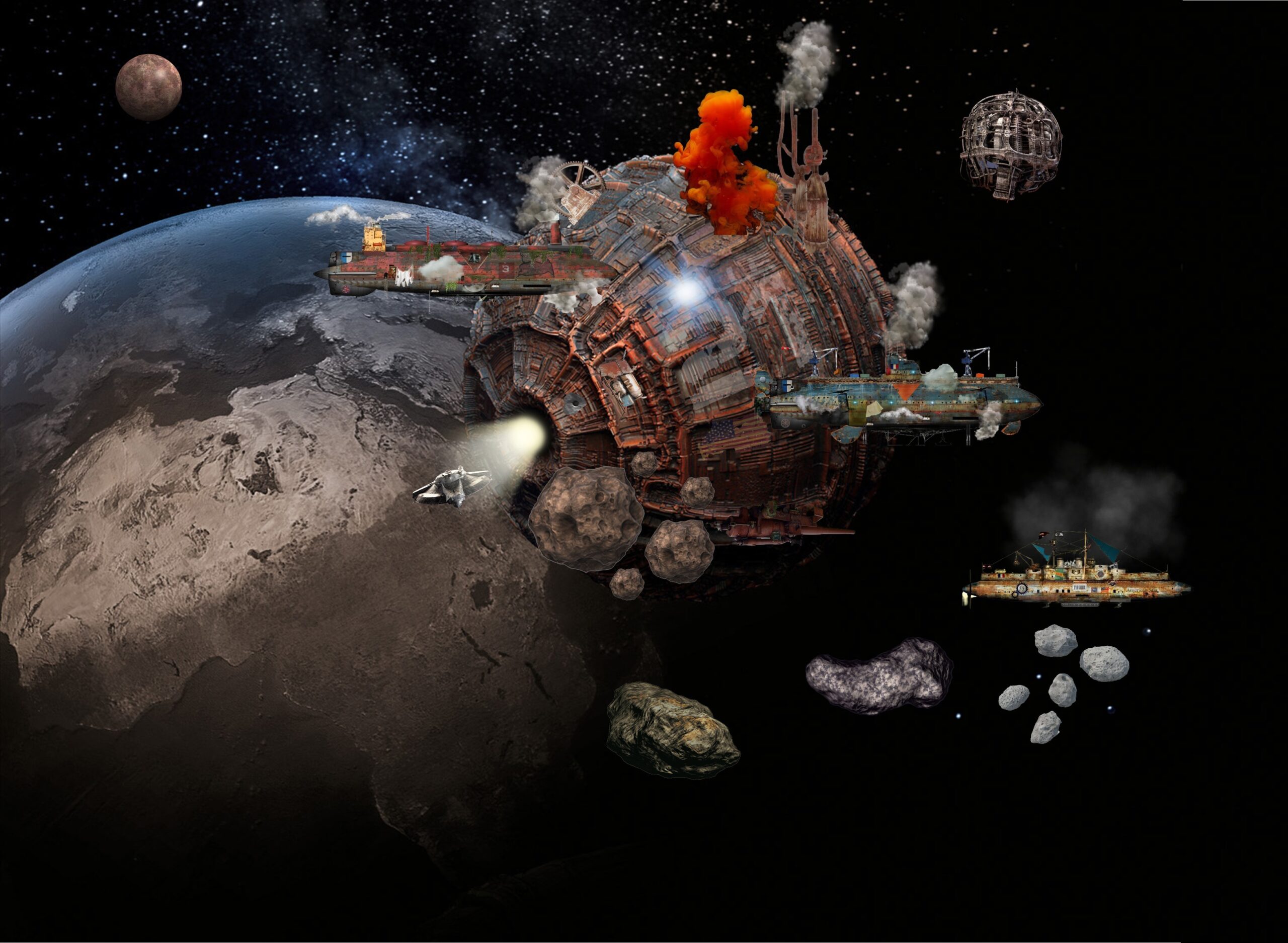
Asteroid mining and resource extraction refers to the hypothetical process of extracting valuable materials from asteroids, which are rocky bodies found orbiting the sun. While currently not a commercial reality, it has the potential to be a game-changer for resource acquisition in the future. Here’s a breakdown of the concept:
What are Asteroids?
Imagine giant, leftover chunks from the formation of our solar system. These irregularly shaped celestial bodies, mostly composed of rock and metal, are called asteroids. They come in various sizes, ranging from a few meters to hundreds of kilometers in diameter. While most asteroids reside in the asteroid belt between Mars and Jupiter, some, known as near-Earth objects (NEOs), venture closer to our planet’s orbit.
Why Mine Asteroids?
Asteroids are believed to be rich in various resources, including:
- Precious metals: Platinum, gold, and other valuable metals are found in higher concentrations on asteroids compared to Earth’s crust.
- Water ice: Some asteroids contain water ice, which could be a crucial resource for future space exploration and potential colonization efforts.
- Building materials: Asteroids could provide raw materials like iron and nickel for constructing habitats and infrastructure in space.
Potential Benefits of Asteroid Mining:
The vast expanse of space holds not only celestial wonders but also the potential for valuable resources. Asteroid mining, while still in its early stages, offers a glimpse into a future where we can access these riches, unlocking a multitude of potential benefits:
1. Securing a Sustainable Resource Future:
- Mitigating resource depletion: Earth’s resources are finite, and some critical materials are facing depletion. Asteroids, on the other hand, are believed to be rich in various elements, including platinum, gold, and rare earth metals, offering a potentially long-term and sustainable source for various industries.
- Reducing environmental impact: Traditional mining on Earth can have a significant environmental impact. Extracting resources from asteroids could potentially offer a more sustainable alternative, with minimal impact on our planet’s ecosystems.
2. Fueling Space Exploration and Colonization:
- Enabling self-sustaining space bases: Extracting water ice from asteroids could be crucial for establishing and sustaining human presence in space. Water is not only essential for life but can also be broken down into hydrogen and oxygen, vital for rocket fuel and creating breathable atmospheres in space habitats.
- Providing building materials: Asteroids are abundant in resources like iron and nickel, which are essential for constructing space infrastructure like habitats, research stations, and even spaceships. This could significantly reduce the cost and logistical challenges of transporting such materials from Earth.
3. Boosting Technological Advancements:
- Access to rare elements: Asteroids contain rare elements that are difficult or expensive to find on Earth. These elements play a crucial role in developing cutting-edge technologies in various fields, including electronics, renewable energy, and medicine. Access to these resources could lead to the advancement of existing technologies and even the creation of entirely new ones.
4. Economic Growth and Job Creation:
- New industries and opportunities: The development of asteroid mining technology and operations could create new industries, generating economic growth and job opportunities in various sectors, such as space engineering, robotics, and resource management.
- Global collaboration: Addressing the challenges and realizing the potential of asteroid mining will likely require international collaboration, fostering cooperation and promoting peaceful scientific exploration.
Challenges of Asteroid Mining:
Here’s a closer look at some of the major hurdles that need to be overcome:
1. Technological Hurdles:
- Space travel: Reaching and maneuvering near asteroids requires overcoming vast distances and navigating the complexities of space travel. Currently, spacecrafts are expensive to launch and operate, making frequent trips for mining purposes economically challenging.
- Extraction methods: Developing efficient and cost-effective techniques for extracting resources from asteroids in the harsh space environment is crucial. This includes methods for drilling, scooping, or vaporizing the asteroid material, followed by processing and collection.
- In-situ resource utilization (ISRU): Utilizing resources extracted from asteroids directly in space, rather than transporting them back to Earth, presents additional technological challenges. This could involve processing the materials into usable forms for building space habitats, refueling spacecraft, or creating other necessary elements in space.
2. Financial Constraints:
- High costs: The entire process of asteroid mining, from research and development to launch, operation, and resource extraction, is currently very expensive. Developing the necessary infrastructure and technology is a significant financial undertaking, requiring substantial investment and potentially international collaboration.
- Economic viability: Until the technology matures and costs become more manageable, the economic viability of asteroid mining remains questionable. Extracting resources and transporting them back to Earth needs to be cost-effective to compete with existing terrestrial resources.
3. Legal and Ethical Considerations:
- International space law: The existing legal framework for space exploration and resource utilization needs further definition and international agreement. The Outer Space Treaty establishes general principles, but specific regulations regarding asteroid mining are still under development.
- Planetary protection: Ensuring that asteroid mining activities don’t inadvertently contaminate Earth or other celestial bodies with harmful materials is critical. Additionally, mitigating the risk of altering the trajectory of asteroids and potentially endangering Earth is an important consideration.
4. Environmental and Sustainability Concerns:
- Space debris: Launching and operating spacecraft for asteroid mining contributes to the growing problem of space debris. Mitigating the creation of new debris and ensuring responsible disposal of spacecraft and equipment is crucial for maintaining a sustainable space environment.
- Environmental impact on Earth: While potentially providing a more sustainable source of resources compared to traditional mining on Earth, the environmental impact of asteroid mining needs thorough assessment. This includes analyzing the potential environmental consequences of launching large rockets and processing extracted materials.
Here are some of the resources that could be extracted from asteroids:
1. Precious Metals:
- Platinum Group Metals (PGMs): These include platinum, palladium, iridium, and rhodium, used in various applications like catalytic converters, electronics, and jewelry. Asteroids are believed to hold much higher concentrations of these metals compared to Earth’s crust, making them potentially valuable resources.
- Gold: While not the primary target, gold could also be present in some asteroids and potentially be extracted.
2. Water Ice:
- H2O: The presence of water ice on some asteroids holds immense potential for space exploration and colonization. Water is not only essential for life support but can also be broken down into hydrogen and oxygen, vital for:
- Fuel: Hydrogen is a fuel source for rockets, and oxygen is essential for combustion and creating breathable atmospheres.
- Life support: Water is crucial for sustaining human life and potentially sustaining life in future space habitats.
- Fuel: Hydrogen is a fuel source for rockets, and oxygen is essential for combustion and creating breathable atmospheres.
3. Building Materials:
- Iron and Nickel: These are essential components in the production of steel and other alloys used for construction. Asteroids are believed to be rich in these elements, potentially providing a readily available source for building space infrastructure like:
- Habitats: Building materials for space stations and research facilities.
- Spacecraft: Components like hulls and structures for future spacecraft.
- Habitats: Building materials for space stations and research facilities.
4. Other Resources:
- Rare Earth Elements (REEs): These elements are crucial for various technologies like electronics, magnets, and renewable energy applications. Asteroids could potentially offer a source for these valuable but scarce materials.
It’s important to note that: - The specific resources present in any given asteroid vary greatly. Careful analysis and exploration are crucial for determining the feasibility of resource extraction.
- The technology for efficiently extracting and processing these resources in the harsh space environment is still under development.
- The economic viability of extracting and transporting resources from asteroids back to Earth needs careful consideration.
Economic Potential of Asteroid Mining:
| Benefit | Description | Example |
|---|---|---|
| Securing a sustainable resource future | Mitigates resource depletion on Earth and offers a long-term source for various industries. | Access to platinum and rare earth elements, crucial for electronics and renewable energy. |
| Reducing environmental impact | Minimizes damage to Earth’s ecosystems compared to traditional mining practices. | Potentially reduces reliance on terrestrial mining for critical materials. |
| Fueling space exploration and colonization | Enables self-sustaining space bases and provides building materials for space infrastructure. | Extracting water ice for breaking down into fuel and creating breathable atmospheres. |
| Boosting technological advancements | Provides access to rare elements for developing cutting-edge technologies. | Utilizing asteroid resources for advancements in electronics, medicine, and renewable energy. |
| Economic growth and job creation | Creates new industries and job opportunities in space engineering, robotics, and resource management. | Fostering economic growth and attracting investments in space exploration and resource utilization. |
| Global collaboration | Requires international cooperation, potentially promoting peaceful scientific exploration. | Collaboration on research, development, and regulation of asteroid mining activities. |
Technologies for Asteroid Mining:
While asteroid mining remains a future endeavor, several potential technologies are being explored to make it a reality. These technologies need further development and refinement, but they offer a glimpse into how we might extract resources from these celestial bodies:
1. Robotic Exploration and Extraction:
- Prospector spacecraft: These robotic probes would be sent to scout asteroids, analyzing their composition and identifying potential resource targets.
- Mining robots: Once potential resource deposits are identified, specialized robots equipped with drills, scoops, or lasers could be deployed to extract the desired materials.
- Autonomous operation: Advanced AI and robotics would likely play a crucial role in enabling these robots to operate autonomously in the harsh space environment.
2. In-Situ Resource Utilization (ISRU):
- This approach focuses on utilizing the extracted materials directly in space rather than transporting them back to Earth.
- Processing and refining technologies would be needed to convert raw materials into usable forms for various purposes, such as:
- Water ice processing: Breaking down water ice into hydrogen and oxygen for fuel and life support.
- Metal refining: Extracting and refining metals for building space infrastructure.
- Manufacturing: Utilizing extracted resources to build essential components directly in space.
- Water ice processing: Breaking down water ice into hydrogen and oxygen for fuel and life support.
3. Resource Retrieval and Transportation:
- Spacecraft for transportation: Once extracted, resources might be transferred to specialized containers or capsules and launched back to Earth or transported to other locations in space for further processing or utilization.
- Resource capture and containment technologies: Techniques for safely capturing and containing the extracted materials in the space environment are crucial.
4. Advanced Propulsion Systems:
- Reaching and maneuvering near asteroids efficiently requires advanced propulsion systems. These could involve:
- Electric propulsion: Utilizing electric fields to accelerate ions for efficient and controlled spacecraft movement.
- Nuclear propulsion: Utilizing nuclear energy to power spacecraft for longer journeys and heavier payloads.
- Electric propulsion: Utilizing electric fields to accelerate ions for efficient and controlled spacecraft movement.
5. Space-Based Infrastructure:
- Establishing a network of space-based facilities could be crucial for supporting asteroid mining operations. This could include:
- Refueling stations: Providing fuel for spacecraft involved in mining activities and deeper space exploration.
- Processing and manufacturing facilities: Enabling the processing of extracted resources and potentially creating materials needed for further space exploration endeavors.
- Refueling stations: Providing fuel for spacecraft involved in mining activities and deeper space exploration.
Conclusion:
Asteroid mining, while still in its nascent stages, holds the potential to revolutionize our access to resources. From securing a sustainable future to fueling space exploration, the potential benefits are numerous. However, technological advancements, economic viability, and addressing legal and environmental concerns remain crucial hurdles. Despite the challenges, the potential rewards of unlocking the riches of asteroids continue to drive innovation, making it a captivating prospect for the future of resource extraction and space exploration.
References:
- National Aeronautics and Space Administration (NASA): https://www.nasa.gov/general/is-nasa-mining-asteroids-we-asked-a-nasa-scientist-episode-41/
- The Planetary Society: https://www.reddit.com/r/EliteDangerous/comments/twxtn9/asteroid_mining_vs_planetary_mining_which_is/
- Massachusetts Institute of Technology (MIT) Technology Review: https://www.technologyreview.com/2022/12/19/1063988/whats-in-an-asteroid/
FAQs
1. What resources can be extracted from asteroids?
Asteroids are believed to hold a treasure trove of resources, including:
Precious metals: Platinum, gold, and other valuable metals are found in higher concentrations on asteroids compared to Earth’s crust.
Water ice: Some asteroids contain water ice, which could be a crucial resource for future space exploration and potential colonization efforts.
Building materials: Asteroids could provide raw materials like iron and nickel for constructing habitats and infrastructure in space.
Rare earth elements: These elements are crucial for various technologies but are scarce on Earth. Asteroids might offer a potential source.
2. How do you extract minerals from asteroids?
While still in development, several potential methods for extracting resources from asteroids are being explored:
Robotic mining: Robots equipped with drills, scoops, or lasers could be sent to collect materials from the asteroid’s surface.
Laser vaporization: Using lasers to vaporize the surface and collect the resulting “space dust” for further processing.
Solar heating: Focusing sunlight onto the asteroid to break down the rock, allowing for easier collection of the resulting fragments.
3. How can asteroid mining help the environment?
Compared to traditional mining on Earth, asteroid mining could offer some environmental benefits:
Reduced impact: Extracting resources from space wouldn’t directly damage Earth’s ecosystems as traditional mining can.
Sustainable source: Asteroids could offer a potentially long-term and sustainable source of resources, reducing our reliance on depleting Earth’s reserves.
4. What is the concept of asteroid mining?
Asteroid mining refers to the hypothetical process of extracting valuable resources from asteroids orbiting the sun.
The concept involves:
Identifying and reaching target asteroids: Utilizing spacecraft and exploration methods to locate and travel to these celestial bodies.
Extracting desired resources: Employing various techniques to collect and process the targeted materials like metals, water ice, or building materials.
Utilizing or transporting resources: Depending on the specific goals, extracted resources could be used in space for infrastructure or fuel, or potentially transported back to Earth for various applications.







